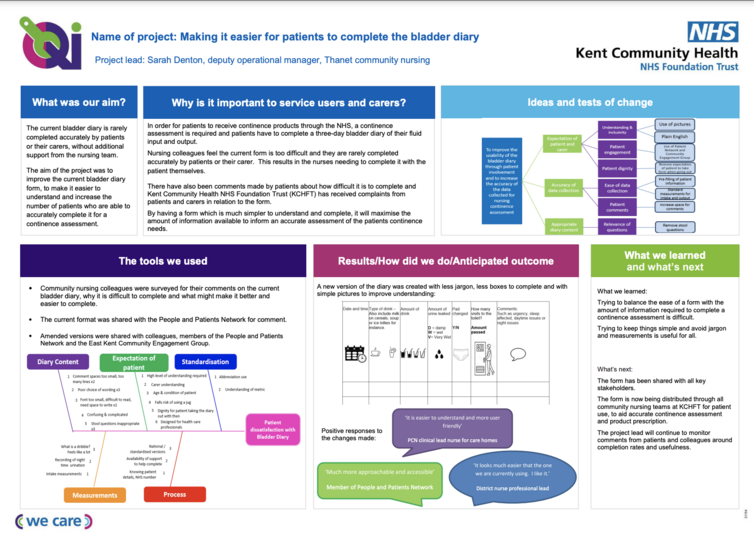Continence issues can have a big impact on people’s lives, which is why an accurate assessment of their condition is important.
To this end, a bladder diary used by community nursing teams at Kent Community Health NHS Foundation Trust (KCHFT) has been redesigned, to make it easier for patients to complete. It will give health specialists a good understanding of the person’s issues and what could be done to help.
Changes were made to a previous bladder diary following a patient complaint, which said there was too much information to fill in and that it was complicated. As a result of this, a community nursing team in Thanet, Kent, spoke with people who had been using the diary, to see the bits they struggled with and to get their ideas on how it could be improved.
The team who ran the quality improvement project were deputy operational manager Sarah Denton, Wendy Orr, Melanie Oram, Kim Rowe and Rebecca Crew.
Sarah, pictured, said: “The feedback we had about the previous bladder diary was that it was aimed more at clinicians rather than our patients, so that was something we wanted to change. Just because we had always done things in a particular way, didn’t mean we had to continue doing so.
“Previously we had assumed that everyone can read, write and understand English and we realised this is not the case and we wanted to do something about it. We wanted to make it easier for everyone to understand and use.
“We have only just started sharing the new version with community nursing teams and patients, but the feedback so far has been very positive. As a trust, this project contributes to the quadruple aim in enhancing the patient and carer experience.”
Before the improvements were made, the service was finding that the bladder diary was rarely completed accurately by patients or their carers, if there was not additional support from the nursing team. The aim of the project was to improve the diary, to make it easier for patients to understand and to increase the number of patients who were able to accurately complete it, for a continence assessment.

For patients to receive continence products through the NHS, a continence assessment is required, which involves people recording how much they drink, their number of visits to the toilet, the frequency of their visits and other information.
Sarah and her team consulted members of the East Kent Community Engagement Group, KCHFT’s People and Patients Network and colleagues. A new version of the diary was created with less jargon, less boxes to complete and with simple pictures to improve understanding.
A clinical lead nurse from a local primary care network said: “It is easier to understand and more user friendly.” A district nurse professional lead said: “It looks much easier that the one we are currently using. I like it.”
Feedback from those using the diary will continue to be monitored.

